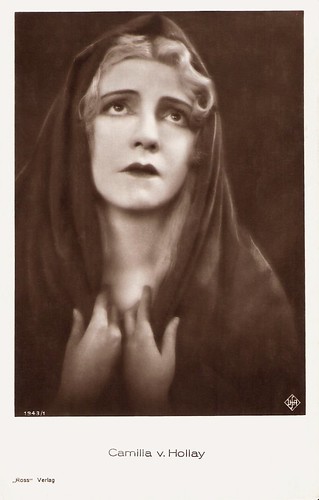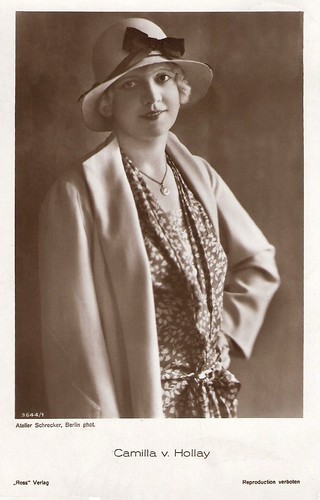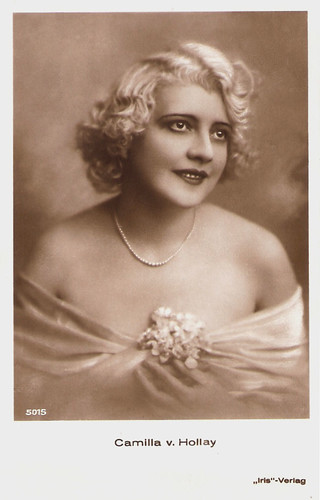Camilla von Hollay (1899–1967) was a Hungarian film actress of the silent era. She appeared in more than 40 films between 1916 and 1930, first in Hungary and later in Germany.
Image may be NSFW.
Clik here to view.
German postcard by Ross Verlag, no. 1943/1, 1927-1928. Photo: Ufa.
Camilla von Hollay was born as Kamillá Hollai in Budapest, Austria-Hungary (now Hungary).
Her father, the industrialist Adalbert Hollay, wanted her to study medicine after finishing school. Against her parents' will she visited an acting school in 1915. For two years she played in Budapest theatres in plays like Liliom and Pygmalion.
According to German Wikipedia her film debut was already in 1913 in an unknown Hungarian silent film. From 1916 on she started to appear regularly in the cinema billed as Kamilla Hollai. Her second film was Mire megvénülünk/What is Shallow (Ödön Uher jr., 1916).
In the films A régiséggyütjö/The Antiquarian (Alfréd Deésy, 1917), Casanova (Alfréd Deésy, 1918) and the Oscar Wilde adaptation Az élet kiralya/The Picture of Dorian Gray (Alfréd Deésy, 1918), she appeared at the side of Arisztid Olt.
Image may be NSFW.
Clik here to view.
Bulgarian postcard by gr Paskob, Sofia, 1929. Photo: publicity still for Überflüssige Menschen/Superfluous People (Aleksandr Razumnyj, 1926).
In 1922, Kamillá Hollai went to Berlin to take over the lead in Das Feuerschiff/The Fire Ship (Richard Löwenbein, 1922). In Germany she changed her name into Camilla von Hollay.
During the 1920s she starred in such German films as Ein Traum vom Glück/A Dream of Happiness (Paul L. Stein, 1924) with Harry Liedtke, Die Wiskottens (Arthur Bergen, 1926), Madame wünscht keine Kinder/Madame Doesn't Want Children (Alexander Korda, 1927), the Asta Nielsen vehicle Gehetzte Frauen/Agitated Women (Richard Oswald, 1927), Die Weber/The Weavers (Friedrich Zelnik, 1927) with Paul Wegener, and Waterloo (Karl Grune, 1928) starring Charles Vanel.
The sound film didn't offer her demanding roles - probably because of her Hungarian accent. She only acted in minor roles in films like Die zärtlichen Verwandten/Beloved Family (Richard Oswald, 1930) and Tingel-Tangel (Jaap Speyer, 1931) featuring Ernö Verebes.
In 1931 she married a journalist and retired. Camilla von Hollay died in Budapest in 1967. She was 67.
Image may be NSFW.
Clik here to view.
German postcard by Ross Verlag, no. 3644/1, 1928-1929. Photo: Atelier Schrecker, Berlin.
Image may be NSFW.
Clik here to view.
Austrian postcard by Iris-Verlag, no. 5015.
Sources: Thomas Staedeli (Cyranos), Hungarian movie database (Hungarian), Wikipedia (Engels and German), and IMDb.
Image may be NSFW.
Clik here to view.

German postcard by Ross Verlag, no. 1943/1, 1927-1928. Photo: Ufa.
Count Dracula
Camilla von Hollay was born as Kamillá Hollai in Budapest, Austria-Hungary (now Hungary).
Her father, the industrialist Adalbert Hollay, wanted her to study medicine after finishing school. Against her parents' will she visited an acting school in 1915. For two years she played in Budapest theatres in plays like Liliom and Pygmalion.
According to German Wikipedia her film debut was already in 1913 in an unknown Hungarian silent film. From 1916 on she started to appear regularly in the cinema billed as Kamilla Hollai. Her second film was Mire megvénülünk/What is Shallow (Ödön Uher jr., 1916).
In the films A régiséggyütjö/The Antiquarian (Alfréd Deésy, 1917), Casanova (Alfréd Deésy, 1918) and the Oscar Wilde adaptation Az élet kiralya/The Picture of Dorian Gray (Alfréd Deésy, 1918), she appeared at the side of Arisztid Olt.
Olt would soon become known as Béla Lugosi and he became a Hollywood icon in his legendary role as Count Dracula.
Image may be NSFW.
Clik here to view.

Bulgarian postcard by gr Paskob, Sofia, 1929. Photo: publicity still for Überflüssige Menschen/Superfluous People (Aleksandr Razumnyj, 1926).
Berlin
In 1922, Kamillá Hollai went to Berlin to take over the lead in Das Feuerschiff/The Fire Ship (Richard Löwenbein, 1922). In Germany she changed her name into Camilla von Hollay.
During the 1920s she starred in such German films as Ein Traum vom Glück/A Dream of Happiness (Paul L. Stein, 1924) with Harry Liedtke, Die Wiskottens (Arthur Bergen, 1926), Madame wünscht keine Kinder/Madame Doesn't Want Children (Alexander Korda, 1927), the Asta Nielsen vehicle Gehetzte Frauen/Agitated Women (Richard Oswald, 1927), Die Weber/The Weavers (Friedrich Zelnik, 1927) with Paul Wegener, and Waterloo (Karl Grune, 1928) starring Charles Vanel.
The sound film didn't offer her demanding roles - probably because of her Hungarian accent. She only acted in minor roles in films like Die zärtlichen Verwandten/Beloved Family (Richard Oswald, 1930) and Tingel-Tangel (Jaap Speyer, 1931) featuring Ernö Verebes.
In 1931 she married a journalist and retired. Camilla von Hollay died in Budapest in 1967. She was 67.
Image may be NSFW.
Clik here to view.

German postcard by Ross Verlag, no. 3644/1, 1928-1929. Photo: Atelier Schrecker, Berlin.
Image may be NSFW.
Clik here to view.

Austrian postcard by Iris-Verlag, no. 5015.
Sources: Thomas Staedeli (Cyranos), Hungarian movie database (Hungarian), Wikipedia (Engels and German), and IMDb.